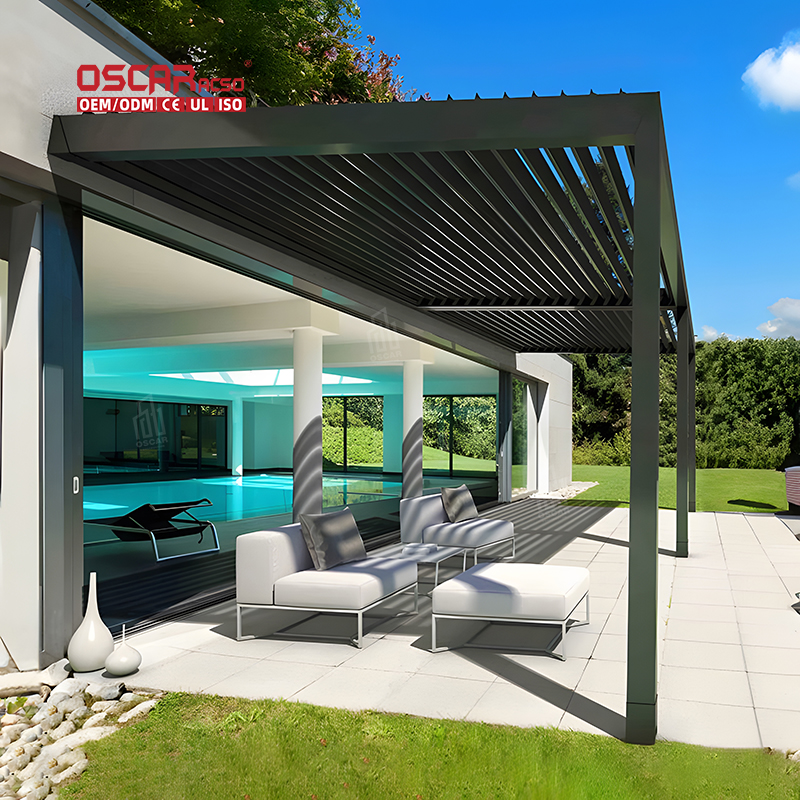Motorized Louver Pergola Systems, Revolutionize Your Patio with Smart Weather Protection
🌞 Imagine controlling your patio\'s sunlight and shade with just a button—motorized louver pergola systems are transf...
🌞 Imagine controlling your patio’s sunlight and shade with just a button—motorized louver ซุ้มไม้เลื้อย systems are transforming outdoor living. These retractable structures combine aluminum durability with intelligent design, allowing you to adapt to weather changes instantly. Why are they gaining popularity? They offer a seamless blend of aesthetics and functionality, turning any garden or balcony into a versatile, all-season retreat. Let’s explore how these systems work and why they might be your next home upgrade!
.jpg)
What Exactly is a Motorized Louver Pergola?
A motorized louver pergola features adjustable aluminum louvers that rotate to control light, ventilation, and rain protection. Unlike fixed covers, these systems can be tilted open for full sun or closed completely for waterproof shelter. The electric operation—often via remote or app—ensures effortless adjustment. For example, some kits include IP67-rated waterproofing and LED lighting for evening ambiance, making them ideal for hosting gatherings rain or shine. How does it differ from traditional pergolas? Traditional ones offer passive shade, while motorized versions provide active climate control—like swapping a manual fan for a smart AC!
.jpg)
Key Benefits: Why Homeowners Are Investing
The advantages extend beyond basic shade. Here’s a breakdown of standout features:
- •
Weather adaptability: Louvers can be angled to block rain or allow breeze, with some models supporting snow load capacities and wind resistance.
- •
UV protection and privacy: Materials like polyester covers or powder-coated aluminum reflect harmful rays while creating a secluded space.
- •
Energy efficiency: By reducing heat gain, they lower indoor cooling costs—a perk I’ve seen cut summer AC bills by up to 20% in temperate zones.
- •
Low maintenance: Aluminum frames resist rust and corrosion, requiring only occasional cleaning compared to wood’s yearly sealing.

💡 Personal insight: Having tested similar systems, the real win is their multi-season utility—they’re as useful for winter snow shelter as for summer picnics!
Installation and Daily Use: Simpler Than You Think
Worried about complex setup? Many kits come with pre-assembled components and hardware, though adult assistance is recommended for anchoring. The process typically involves:

- 1.
Securing the frame to patios or decks with corrosion-resistant bolts.
- 2.
Connecting the motor to a power source (solar options are emerging).
- 3.
Testing the louver mechanism to ensure smooth rotation.
Operationally, users can program settings—like auto-closing during rain—via smart home integration. A common question: What if power fails?Most systems include manual overrides, such as hand cranks, for reliability.
Material and Design Choices: Balancing Cost and Quality
Options range from economical polyester blends to premium aluminum-glass combos. Highlights include:
.jpg)
- •
Aluminum alloys: Lightweight yet strong, often with powder coatings for color customization (e.g., white, gray, black).
- •
Polycarbonate or glass panels: These add insulation but may increase costs; double-paned glass is better for noise reduction.
- •
Budget considerations: Basic models start around 300,whilehigh−endmotorizedkitscanexceed800—justified by longer warranties (e.g., 3 years).
🔧 My take: Splurging on WPC (wood-plastic composite) hybrids pays off in durability, especially in humid climates where wood warps quickly.
Future Trends: Where Outdoor Tech Is Headed
Innovations are pushing beyond basic retraction. Expect AI-driven climate response—where systems sync with weather apps—and modular designs that expand coverage. Industry data suggests a 30% annual growth in smart pergola sales, driven by urban gardening trends. The core evolution? From static structures to dynamic outdoor rooms that blend tech with nature.

